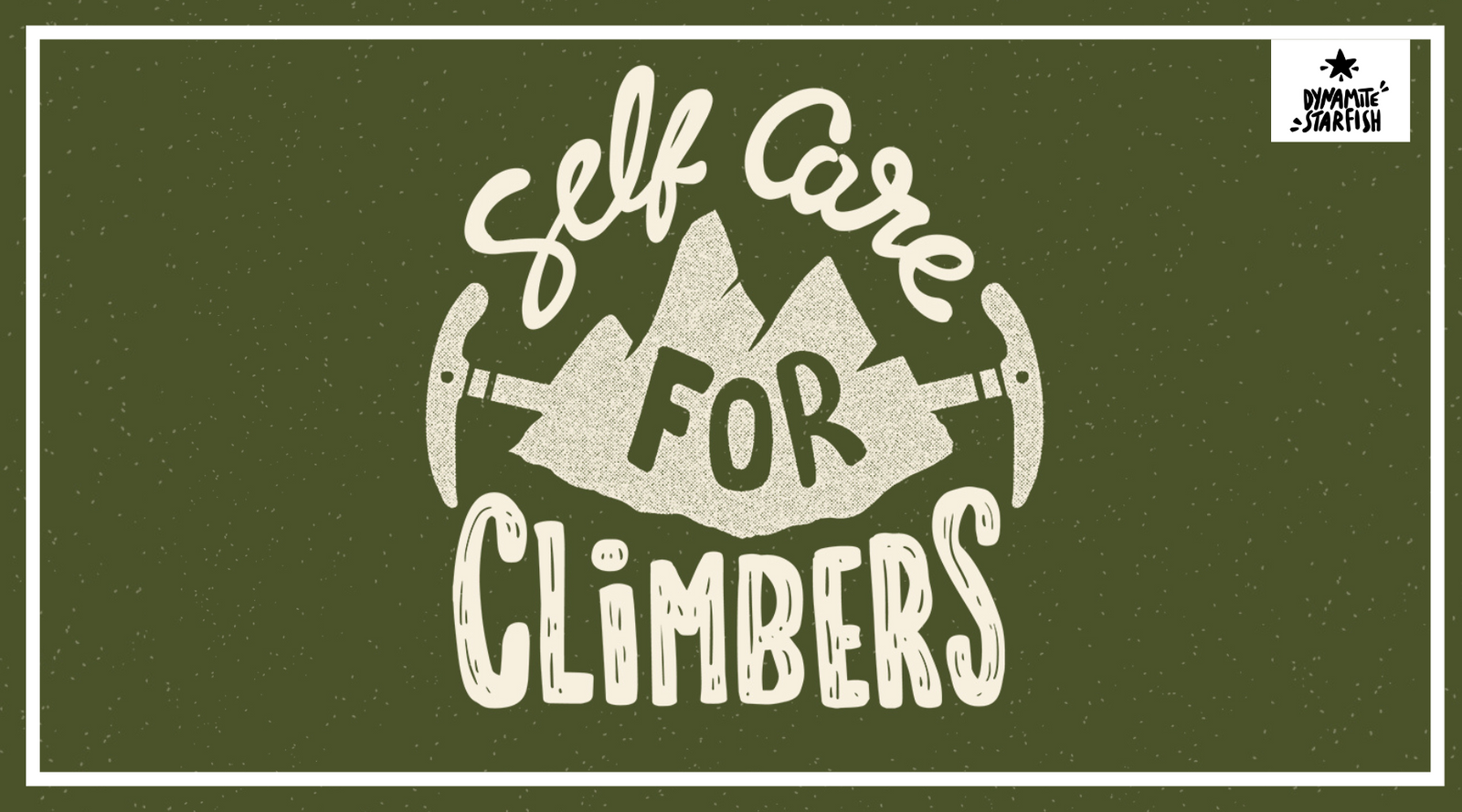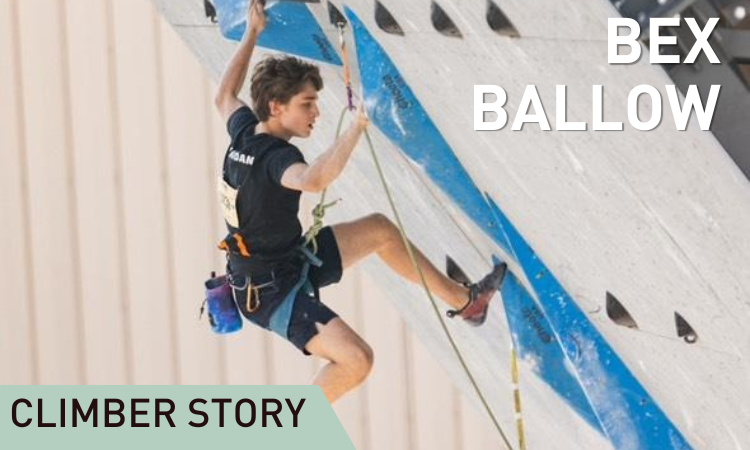Your Cart is Empty
FREE USA SHIPPING ON ORDERS OVER $65!
FREE USA SHIPPING ON ORDERS OVER $65!
Self Care For Climbers
October 25, 2023 5 min read

Get 8 hours of sleep, exercise regularly, take a break from social media, eat healthy foods, spend time outside...these are the same self care tips we've been hearing for ages.
Maybe you're already a pro at taking 'me days' to navigate life's stress at your best. But can you say the same about yourself as a climber?
While climbing in itself can be a healthy part of your self care routine, it's important to show yourself a little love when you're on the wall too!
Keep scrolling to read our guide on self care for climbers inspired by our very own Dynamite Starfish community.
Restday bestday

Ever heard someone bragging about a trip where they climbed [insert ridiculous number] days without a single day off? It's not a badge of honor we recommend pinning to your down jacket...
We totally get it when we hear folks tell us things like 'I can't send my proj if I stay at home', 'I don't want to lose my strength gains', and 'yesterday I bouldered in the cave, today I'll do slabs, tomorrow is coordination, this weekend is sport climbing.'
As tempting as it is, if you push yourself day in and day out, your body will eventually say stop. A general rule of thumb for most folks is to alternate at least one rest day for every two climbing days. Sprinkle in an extra rest day any time you feel off and allow 1-2 complete rest days from sports per week.
(Photo courtesy of @michelle.b_ventures)
Find yourself feeling guilty about taking rest days? Check out these positive affirmations from the Dynamite Starfish family:
"Take breaks. Like a good week-long break even. Use it to catch up on sleep and enjoy some other activities. I personally have come back from them stronger and more motivated to train. It’s okay to take days off from climbing." @_krisstiee
"Sometimes I'll go to the gym with a plan and then lay on the mats. It's ok! Listen to your body, nourish it, and recover it well!" @yokochi1
"Naps so many naps. And always have a backup sport to get you through injuries." @jenrau
"Bring some snacks, don’t feel bad about taking a lil crag nap." @erin.m.o
"Sleep." @williamalexanderthegreat
Sand those callouses with 80 grit sandpaper on a paint stick

OK...please don't actually run to Home Depot to buy paint sticks and the coarsest sandpaper available to mankind so you can rub your tips to a pulp.
What we're getting at here is that skin pain is often the limiting factor when it comes to longer climbing sessions, and a little skin care goes a long way!
"Hand care has been crucial for me. When I first started, I ignored this and ended up constantly climbing with taped-up fingers. Now, after each session, I use a file specifically for climbers to smooth out all the dry skin and then apply lotion. It's made all the difference in the world since it's much easier to climb without tape everywhere." @shaun.climbs
"Same as Shaun, but with foot care for me." @all.snark
A few skin care essentials include: sandpaper or skin file, hand balm or lotion, tape, and nail clippers. Aim to keep your tips and skin between your finger joints smooth using your clippers or sandpaper, and tape sore areas early to avoid unwanted flappers.
As for skin moisture, you may need to experiment with balms and creams to find what works for you — excessive dryness leads to nasty cracks and makes skin more likely to tear!
When it comes to foot care, pick a climbing shoe that is comfortable for your foot and not the one everyone on Instagram uses (more on that here). You can also consider having a slightly larger pair of climbing shoes for warm months when your feet swell.
Pro Tip: Curved cuticle scissors work much better than nail clippers for removing lifted bits of skin that could turn into flappers. Throw a pair in your bag so you can Keep Climbing!
Make note of something you're proud of after every session

Working towards a goal is incredibly motivating, but the drive for bigger success can also act like horse blinders to the little wins we achieve in every climbing session.
One of our favorite ways of breaking through a plateau in climbing is to keep a notebook full of Good Climbs, Good Vibes. For each climbing session, challenge yourself to write down at least one thing you did well. Climbing milestones might include sticking a move or trying a climb on different terrain, and off-the-wall achievements like meeting a new partner or staying in a positive headspace.
Long-term projecting more your jam? Check out these perspectives for keeping the stoke high:
"If you find yourself getting frustrated on a route or specific move, give yourself a limit. Say, I’ll try this move X (I usually say three) more times, then I’m calling it. Often times when I have given myself a limit, I’m able to get the move or finish the route. I don’t know if it’s mental or what, but it works for me. And if you don’t get it in the X amount of tries, call it and try again another day! I used to struggle a lot because I’m very persistent and would try and try and try until I was crying and angry with myself, but this limit system has helped me SO MUCH!" @coe_climbs_rocks
(Photo courtesy of @coe_climbs_rocks)
"If you find yourself becoming mentally fatigued or stressed while trying a project, it's best to pack it up and come back with a fresh mindset another day! It'll be there waiting for you." @alexandertighe
"Don’t compare to others. Focus on you. Encourage others." @rileybignose
Strength train and yoga of course

Does it feel like there's always some kind of nagging ache in your body? Do you get the vibe that your best burns of the day are when you're feeling too tired to send?
If you've never tried it before, dedicating time for a quality warmup along with incorporating a few strength exercises for antagonist muscles and short stretching sessions into your weekly routine can have major benefits on your climbing.
Don't be afraid to 'use energy' during your warmup. Gradually increasing the difficulty level of your climbs or strength exercises helps your body know when it's time to pull hard — warm muscles are also less injury-prone than cold muscles. Similarly, strong antagonists protect your body by balancing out the tension at the joint caused by the bigger muscle groups you use while climbing.
(Photo courtesy of @katiesharkbait)
The flexibility gained through stretching and yoga also reduces the risk of injury by allowing you to scrunch or open your hips into more awkward positions. Can you say 'hello high feet'?!
Not sure where to start? That's OK! The staff at your local rock gym or more experienced climbers are usually more than happy to share their insights. It can take time to notice changes, so be consistent when adding new exercises to your routine for at least 6-8 weeks.
Oh, and don't forget, "You can’t send if you don’t fuel. Pack those snacks and enjoy them!" @kilterkt
Self care isn't selfish, it's necessary to be your best self on and off the wall.
"Don’t feel like you need to be friends with everyone who climbs. Just because you have a common interest, doesn’t mean you need to be friends or to climb together. Find the people who understand you and make you feel seen, safe, and loved! You deserve it ❤️!" @coe_climbs_rocks
If you have questions or ideas you'd like to share about self care for climbers, leave us a comment below! We’d love to hear from you.
Psst…Our Good Climbs, Good Vibes tee is a great conversation starter!
This comfy top lets the world know you're always ready to celebrate the Good Climbs and Good Vibes. With so many styles, we know you’ll be the climber having the most fun at the crag.
SHOP OUR UNISEX CLIMBING APPAREL:
Leave a comment
Comments will be approved before showing up.
Also in News

The Climbing Training Struggles You Can’t Ignore (And How to Overcome Them)
March 19, 2025 6 min read
Read More
Building Trust and Teamwork: Qualities of a Great Climbing Partner
February 12, 2025 4 min read
Read More Recent Articles
- The Climbing Training Struggles You Can’t Ignore (And How to Overcome Them) March 19, 2025
- Building Trust and Teamwork: Qualities of a Great Climbing Partner February 12, 2025
- Climber Story: Bex Ballow January 29, 2025
- 9 Climbing Resolutions for 2025 December 31, 2024
- Climber Story: Kanani Kalahiki December 11, 2024
- 12 Awesome Gift Ideas for Climbers in 2024 November 20, 2024
- Climber Story: Nick Ranelli November 06, 2024
- If climbing was a scary movie, this would be the title... October 30, 2024
- Climber Story: Britney Berkstresser October 02, 2024
- The best (and worst) names for climbing routes we've ever seen September 25, 2024
Subscribe
Sign up to get the latest on sales, new releases and more …
want 15% off?
Get a welcome gift when you sign up with us!


